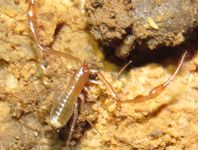Abstract
A new insect species (†Bittacopsocus megacephalus Beutel, Prokop, Müller et Pohl gen. et sp. nov.) is described, based on a single small male (ca. 2.5 mm) embedded in mid Cretaceous Burmese amber. The species shows some resemblance with the mecopteran family Bittacidae, mainly due to strongly elongated and thin legs. However, the structural affinities are apparently due to convergency. Different features, but especially the mouthparts and the pattern of wing venation, indicate that the species belongs to the extinct order †Permopsocida (?Archipsyllidae). However, it differs markedly from all species previously described in this extinct group. The very thin and strongly elongated legs are probably autapomorphic. A very unusual feature is the antenna with only seven segments and extremely elongated flagellomeres. The two pairs of wings are unusually narrow. M and CuA are basally fused. Proximal rows of spines, two series of closed cells, and a distinctly increased number of terminal branches of M are present in the forewings, in contrast to other archipsyllid genera. It is conceivable that Bittacopsocus megacephalus used its long legs to rest suspended in the vegetation like Bittacus. The head structures tentatively suggest predatory behavior but the feeding habits are unclarified yet.
References
Bai, M., Beutel, R.G., Klass, K.-D., Zhang, W., Yang, X.-K. & Wipfler, B. (2016) †Alienoptera—a new insect order in the roach—mantodean twilight zone. Gondwana Research, 39, 317–326.
https://doi.org/10.1016/j.gr.2016.02.002
Bai, M., Beutel, R.G., Zhang, W., Wang, Sh., Hörnig, M., Gröhn, C. Yan, E., Yang, X.-K. & Wipfler, B. (2018) †Caputoraptor elegans—a new Cretaceous insect with a unique cephalo-thoracic scissor device. Current Biology, 28 (3), 438–443.
https://doi.org/10.1016/j.cub.2017.12.031.Batelka, J., Engel, M.S. & Prokop, J. (2018) A remarkable diversity of parasitoid beetles in Cretaceous amber, with a summary of the Mesozoic record of Tenebrionoidea. Cretaceous Research, 90 (2018), 296–310.
https://doi.org/10.1016/j.cretres.2018.04.019
Batelka, J., Prokop, J., Pohl, H., Bai, M., Zhang, W. & Beutel, R.G. (2019) Highly specialized Cretaceous beetle parasitoids (Ripiphoridae) identified with optimized visualization of microstructures. Systematic Entomology, 44 (2), 396–407.
https://doi.org/10.1111/syen.12331
Beutel, R.G. & Gorb, S. (2001) Ultrastructure of attachment specializations of hexapods (Arthropoda): evolutionary patterns inferred from a revised ordinal phylogeny. Journal of Zoological Systematics and Evolutionary Research, 39, 177–207.
https://doi.org/10.1046/j.1439-0469.2001.00155.x
Beutel, R.G. & Gorb, S. (2006) A revised interpretation of the evolution of attachment structures in Hexapoda with special emphasis on Mantophasmatodea. Arthropod Systematics & Phylogeny, 61, 3–35.
Beutel, R.G., Zhang, W. W., Pohl, H., Wappler, T. & Bai, M. (2016) A miniaturized beetle larva in Cretaceous Burmese amber: reinterpretation of a fossil “strepsipteran triungulin”. Insect Systematics & Evolution, 47 (1), 83–91.
https://doi.org/10.1163/1876312X-46052134
Desutter-Grandcolas, L., Jacquelin, L., Hugel, S., Boistel, R., Garrouste, R., Henrotay, M., Warren, B.H, Chinatauan-Marquier, I.C., Nel, P., Grandcolas, P. & Nel, A. (2017) 3-D imaging reveals four extraordinary cases of convergent evolution of acoustic communication in crickets and allies (Insecta). Scientific Reports, 7 (1), 7099.
https://doi.org/10.1038/s41598-017-06840-6
Friedemann, K., Spangenberg, R., Yoshizawa, K. & Beutel, R.G. (2014) The evolution of attachment structures in the highly diverse Acercaria (Hexapoda). Cladistics, 30 (2), 170–201.
https://doi.org/10.1111/cla.12030
Grimaldi, D.A., Engel, M.S. & Nascimbene, P.C. (2002) Fossiliferous Cretaceous Amber from Myanmar (Burma): Its Rediscovery, Biotic Diversity, and Paleontological Significance. American Museum Novitates, 3361, 1–71.
https://doi.org/10.1206/0003-0082(2002)361<0001:FCAFMB>2.0.CO;2
Grimaldi, D., Kathirithamby, J. & Schawaroch, V. (2005) Strepsiptera and triungula in Cretaceous amber. Insect Systematics & Evolution, 36, 1–20.
https://doi.org/10.1163/187631205788912787
Grimaldi, D.A. & Ross, A.J. (2004) Raphidiomimula, an enigmatic new cockroach in Cretaceous amber from Myanmar (Burma) (Insecta: Blattodea: Raphidiomimidae). Journal of Systematic Palaeontology, 2, 101–104.
https://doi.org/10.1017/S1477201904001142
Grimaldi, D.A. & Ross, A.J. (2017) Extraordinary Lagerstätten in amber, with particular reference to the Cretaceous of Burma. In: Fraser, N.C. & Sues, H.-D. (Eds.), Terrestrial Conservation Lagerstätten: Windows into the Evolution of Life on Land. Dunedin Academic Press, Edinburgh, pp. 287–342.
Huang, Di-ying, Nel, A., Azar, D. & Nel, P. (2008) Phylogenetic relationships of the Mesozoic paraneopteran family Archipsyllidae (Insecta: Psocodea). Geobios, 41, 461–464.
https://doi.org/10.1016/j.geobios.2007.11.003
Huang, D.Y., Bechly, G., Nel, P., Engel, M.S., Prokop, J., Azar, D., Casi, Ch.-Y., van de Kamp, T., Staniczek, A.H., Garrouste, R., Krogmann, L., dos Santos Rolo, T., Baumbach, T., Ohlhoff, R., Shmakov, A.S., Bourgouin, T. & Nel. A. (2016) New fossil insect order Permopsocida elucidates major radiation and evolution of suction feeding in hemimetabolous insects (Hexapoda: Acercaria). Scientific Reports, 6, 23004.
https://doi.org/10.1038/srep23004
Liang, F., Zhang, W. & Liu, X. (2016) A new genus and species of the paraneopteran family Archipsyllidae in mid-Cretaceous amber of Myanmar. Zootaxa, 4105 (5), 483–490.
https://doi.org/10.11646/zootaxa.4105.5.4
Nel, A., Prokop, J., Nel, P., Grandcolas, P., Huang, Di-ying, Roques, P., Guilbert, E., Dostál, O. & Szwedo, J. (2012) Traits and evolution of wing venation pattern in paraneopteran insects. Journal of Morphology, 273, 480–506.
https://doi.org/10.1002/jmor.11036
Pohl, H., Batelka, J., Prokop, J., Müller, P., Yavorskaya, M.I. & Beutel, R.G. (2018) A needle in a haystack: Mesozoic origin of parasitism in Strepsiptera revealed by first definite Cretaceous primary larva (Insecta). PeerJ, 6, e5943.
https://doi.org/10.7717/peerj.5943
Prokop, J., Pecharová, M., Garrouste, R., Beattie, R., Chintauan-Marquier, I.C. & Nel, A. (2017) Redefining the extinct orders Miomoptera and Hypoperlida as stem acercarian insects. BMC Evolutionary Biology, 17, 205.
https://doi.org/10.1186/s12862-017-1039-3
Setty, L.R. (1940) Biology and morphology of some north American Bittacidae (Order Mecoptera). The American Midland Naturalist, 23 (2), 257–353.
https://doi.org/10.2307/2420667
Shi, G.H., Grimaldi, D.A., Harlow, G.E., Wang, J., Wang, J., Yang, M.C., Lei, W.Y., Li, Q.L. & Li, X.H. (2012) Age constraint on Burmese amber based on U-Pb dating of zircons. Cretaceous Research, 37, 155–163.
https://doi.org/10.1016/j.cretres.2012.03.014
Szwedo, J. & Nel, A. (2015) The Cretaceous insects: A promising state of the art. Cretaceous Research, 52, 628–630.
https://doi.org/10.1016/j.cretres.2014.07.008
Thornhill, R. (1977) The comparative predatory and sexual behaviour of hangingflies (Mecoptera: Bittacidae). Occasional Papers of the Museum of Zoology, University of Michigan, 677, 1–43.
Vishniakova, V.N. (1976) Relict Archipsyllidae (Insecta: Psocoptera) in the Mesozoic fauna. Paleontological Journal, 10 (2), 180–188.
Yoshizawa, K. & Lienhard, C. (2016) Bridging the gap between chewing and sucking in the hemipteroid insects: new insights from Cretaceous amber. Zootaxa, 4079 (2), 229–245.
https://doi.org/10.11646/zootaxa.4079.2.5

